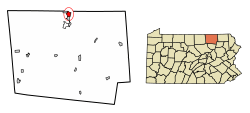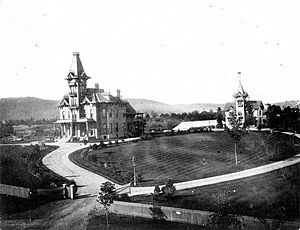Sayre, Pennsylvania facts for kids
Quick facts for kids
Sayre, Pennsylvania
|
|
|---|---|
|
Borough
|
|

Location of Sayre in Bradford County, Pennsylvania.
|
|
| Country | United States |
| State | Pennsylvania |
| County | Bradford |
| Settled | 1871 |
| Incorporated (borough) | 1891 |
| Government | |
| • Type | Borough Council |
| Area | |
| • Total | 2.04 sq mi (5.27 km2) |
| • Land | 2.02 sq mi (5.24 km2) |
| • Water | 0.01 sq mi (0.04 km2) |
| Elevation | 771 ft (235 m) |
| Population
(2010)
|
|
| • Total | 5,587 |
| • Estimate
(2022)
|
5,344 |
| • Density | 2,653.81/sq mi (1,024.64/km2) |
| Time zone | UTC-5 (Eastern (EST)) |
| • Summer (DST) | UTC-4 (EDT) |
| Zip code |
18840
|
| Area code(s) | 570 |
| FIPS code | 42-68096 |
Sayre is a small town, called a borough, located in Bradford County, Pennsylvania, United States. It's part of a larger area known as Northeastern Pennsylvania. Sayre is the main town in the Sayre, PA Micropolitan Statistical Area.
It is about 18 miles (29 km) southeast of Elmira, New York. It is also about 30 miles (48 km) southwest of Binghamton. Sayre is currently the biggest town in Bradford County. Long ago, factories in Sayre made different iron products.
The number of people living in Sayre has changed over time. In 1900, there were 5,243 residents. By 1940, the population grew to 7,569. The most recent count in 2020 showed 5,403 people living there.
Sayre is part of a group of towns called the Penn-York Valley, or "The Valley." This area includes four towns that are close together: Waverly, New York; South Waverly, Pennsylvania; Sayre; and Athens, Pennsylvania. Many smaller towns are also nearby. Together, about 35,000 people live in this valley area.
Contents
Sayre's Early History
In May 1870, a banker from Waverly named Howard Elmer bought land in the Pine Plains area. He bought it with Charles Anthony and James Fritcher. Elmer convinced Asa Packer to build a new railroad repair center there. This center was for the growing Lehigh Valley Railroad. The railroad was expanding north to connect with the Erie Railroad in Waverly.
Robert Heysham Sayre helped make this deal happen. He was the president of the Pennsylvania and New York Railroad. The town was named Sayre in his honor. Sayre officially became a borough on January 27, 1891.
Railroad's Impact on Sayre
In 1904, the main building for the locomotive shops in Sayre was built. People thought it was the largest building in the world under one roof at that time. However, it only held that title for a short period. The railroad operated from 1870 until 1976. But, the maintenance work started to move away before then.
As the railroad industry declined, Sayre's population also decreased after 1940. In 1940, the Pennsylvania Guide described Sayre. It highlighted how important the railroad was to the town. The guide said Sayre was a small railroad settlement. It grew when the Lehigh Valley Railroad built its shops there in 1871.
The guide noted that the railroad shops employed over 1,200 men. These shops were for maintaining, repairing, and storing trains. The railroad completely controlled Sayre's way of life. You could see railroad workers everywhere, wearing their blue denim overalls and tall caps.
Exploring Sayre's Geography
Sayre is located at 41°59′1″N 76°31′15″W / 41.98361°N 76.52083°W. It sits in a river valley within the Allegheny Plateau. This area is just north of where the Susquehanna River and the Chemung River meet. Sayre is part of a larger area called the Penn-York Valley. This valley also includes Athens, Pennsylvania, South Waverly, Pennsylvania, and Waverly, New York.
The border between New York and Pennsylvania runs through this valley. There isn't a clear physical line between the towns. Their streets and avenues connect smoothly from one town to the next. Sayre is surrounded by Athens Township to the east and west. To the south is the borough of Athens. To the northwest is South Waverly, and to the north is Waverly, New York.
Roads and Travel in Sayre
Pennsylvania Route 199 goes through Sayre. It uses streets like Keystone Avenue, Mohawk Street, and Spring Street. This route ends at Interstate 86. This interstate is just across the state line in Waverly, New York.
Using I-86, it's about 17 miles (27 km) northwest to Elmira, New York. If you take New York State Route 17 (which will become I-86), it's about 38 miles (61 km) east to Binghamton, New York.
The United States Census Bureau states that Sayre covers a total area of 2.04 square miles (5.27 km2). Most of this area, 2.02 square miles (5.24 km2), is land. Only a small part, 0.01 square miles (0.04 km2), is water. This means about 0.67% of Sayre's total area is water.
Sayre's Population
| Historical population | |||
|---|---|---|---|
| Census | Pop. | %± | |
| 1880 | 729 | — | |
| 1900 | 5,243 | — | |
| 1910 | 6,426 | 22.6% | |
| 1920 | 8,078 | 25.7% | |
| 1930 | 7,902 | −2.2% | |
| 1940 | 7,569 | −4.2% | |
| 1950 | 7,735 | 2.2% | |
| 1960 | 7,917 | 2.4% | |
| 1970 | 7,473 | −5.6% | |
| 1980 | 6,951 | −7.0% | |
| 1990 | 5,791 | −16.7% | |
| 2000 | 5,813 | 0.4% | |
| 2010 | 5,587 | −3.9% | |
| 2019 (est.) | 5,366 | −4.0% | |
| Sources: | |||
In 2010, the census showed 5,587 people living in Sayre. There were 2,479 households and 1,394 families. The population density was about 2,793.5 people per square mile.
Most residents, 96%, were White. About 0.8% were African American, and 1.7% were Asian. About 1.1% of the population was Hispanic or Latino.
About 27.3% of households had children under 18. The average household had 2.23 people. The average family had 2.94 people. The median age in Sayre was 41 years old.
Notable People from Sayre
Many interesting people have connections to Sayre:
- Arcesia (John Anthony Arcesi), a jazz singer
- Chuck Ciprich, a race car driver
- Colleen Dominguez, a reporter for ESPN
- Peter Cacchione, a communist labor leader who served on the New York City Council
- Donnie Guthrie, a doctor
- Cabot Lyford, a sculptor born in Sayre in 1925
- Red Murray, a baseball player
- Erwin Rudolph, a billiards player
- Robert S. Smith, a priest
- Jeff Terpko, a baseball player
Media and News in Sayre
Sayre has several ways for people to get news and entertainment.
Local Newspapers
- The Morning Times: This newspaper used to be called The Evening Times. It is based in Sayre and covers news for Waverly, Sayre, Athens, and nearby communities.
- Star-Gazette: This paper is based in Elmira, New York. It serves counties in New York like Tioga, Chemung, and Steuben. It also covers Bradford County in Pennsylvania.
- The Daily Review: Based in Towanda, this newspaper covers Bradford County and surrounding areas.
Radio Stations
Sayre and the surrounding Twin Tiers area have several radio stations:
- WEBO - 105.1 FM
- WAVR - 102.1 FM
- WATS - 960 AM
- WENI-FM - 92.7 FM
- W297BG - 107.3 FM
Television Channels
Sayre receives television from three different broadcast markets:
- Binghamton: Includes channels like WBNG (CBS), WIVT (ABC), WBGH (NBC), WICZ (Fox), and WSKG (Public Television).
- Elmira: Includes WETM (NBC), WENY (ABC & CBS), and WYDC (Fox).
- Wilkes-Barre/Scranton: Includes WOLF (Fox), WNEP (ABC), and WYOU (CBS).
Sayre also has Charter Communications' Spectrum News 1.
Transportation in Sayre
Sayre has a bus service called BeST Transit. This bus service makes many stops in Waverly, Sayre, and Athens. It also provides rides to other towns like Towanda, Wysox, Troy, Canton, and the Lycoming Mall.
Sayre and The Valley area also have taxi service. You can get a taxi through Valley Taxi. Pennsylvania Route 199 connects Sayre to Athens and Waverly.
Education in Sayre
Children who live in Sayre attend schools within the Sayre Area School District.
Sayre Community Life

Sayre is home to the Guthrie Robert Packer Hospital and Guthrie Clinic. These are important medical centers for the area.
The community in Sayre also has several organizations:
- Sayre Little League
- Sayre Recreation Program
- Big Brothers/Big Sisters
- 4H
- Community Service Club
- Sayre Library
The Legend of the Horned Giants
There's an old story, an urban legend, about "horned giants" in Sayre. This legend talks about skeletons with horned skulls. The story says these skeletons were found in the 1880s. Dr. G.P. Donehoo, who was a state historian, along with two professors, A.B. Skinner and W.K. Moorehead, supposedly found them. They were excavating a burial mound.
The skeletons were said to be very tall, about 7 feet (2.1 meters) or more. Their skulls reportedly had horn-like bumps above the eyebrows. However, the legend claims these skeletons were lost or stolen while being sent to a museum. It's important to know that none of the official reports from Dr. Donehoo, Skinner, or Moorehead mention finding any human skeletons in Sayre that were giant or had horns. This story is a local legend, not a proven historical fact.
See also
 In Spanish: Sayre (Pensilvania) para niños
In Spanish: Sayre (Pensilvania) para niños



